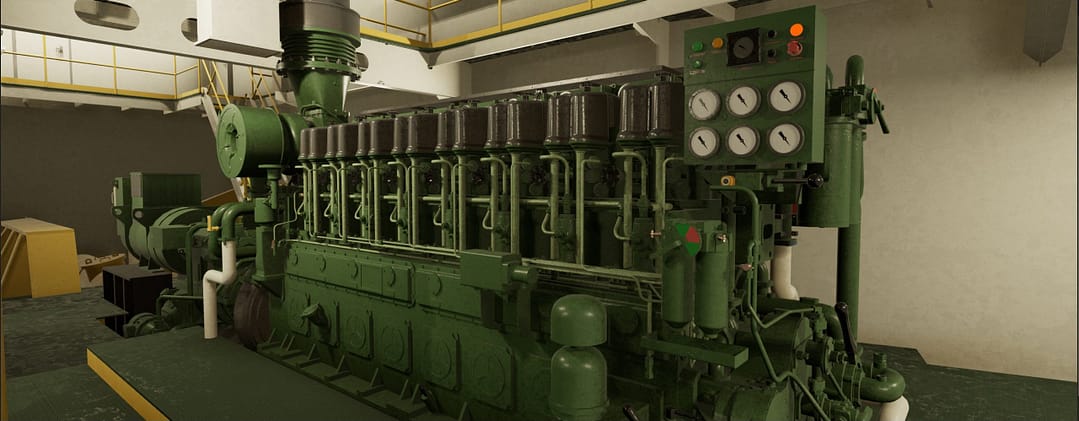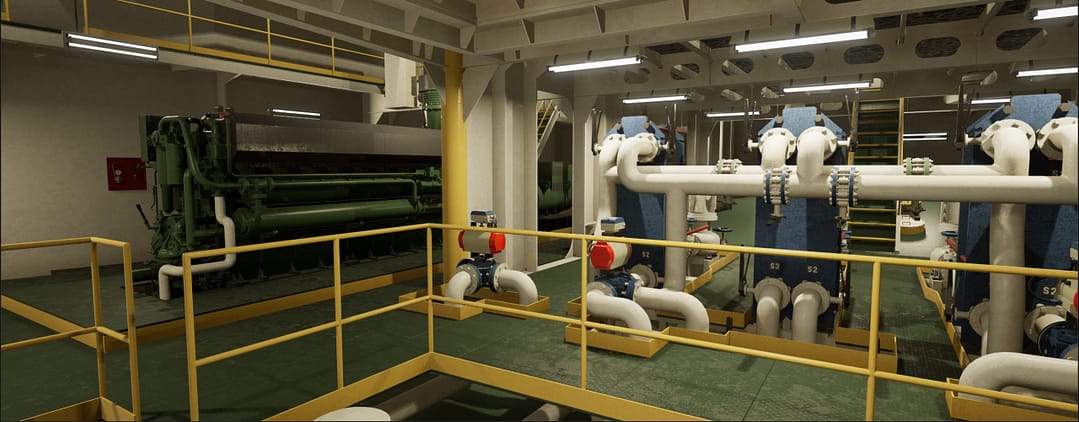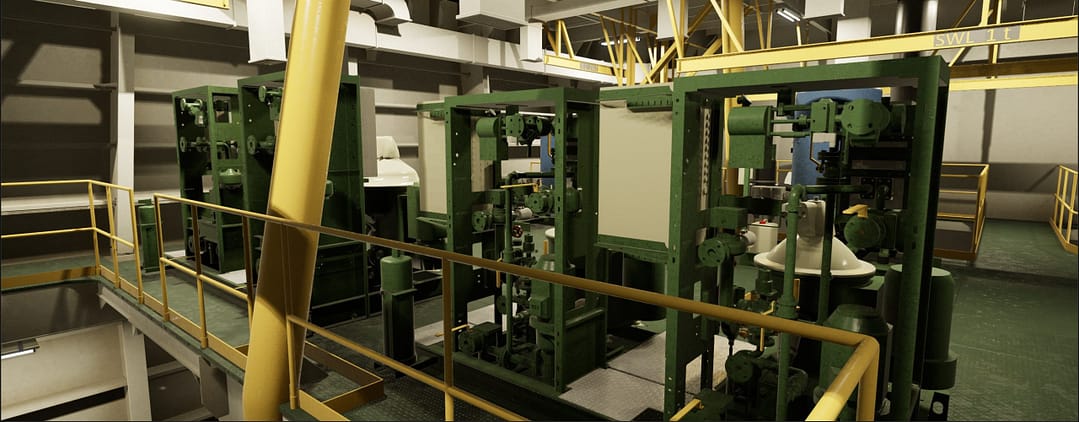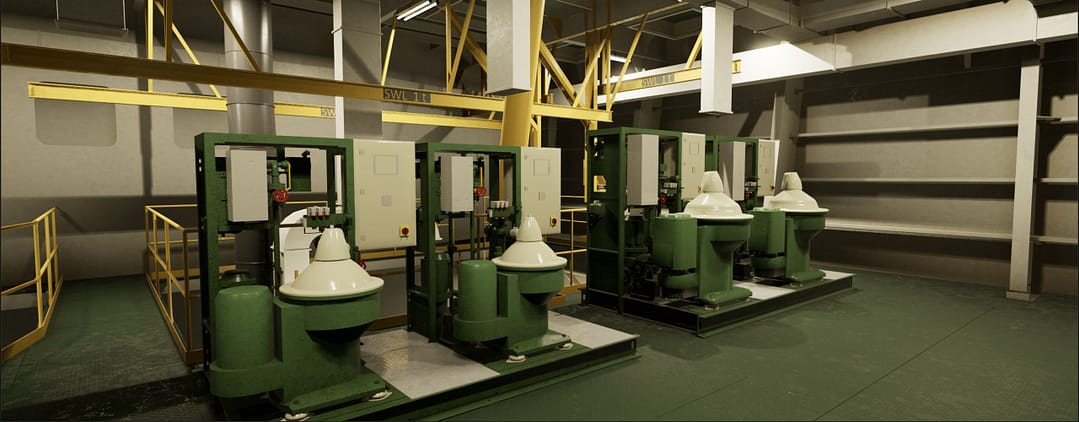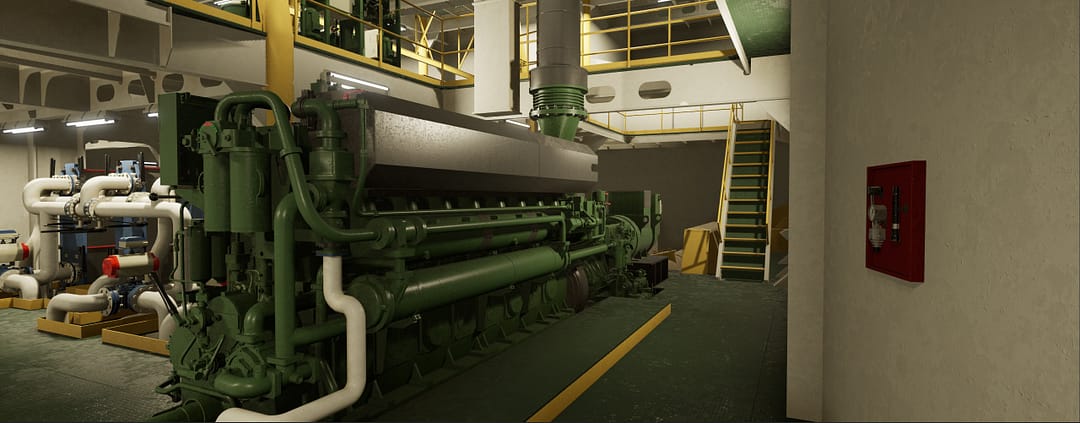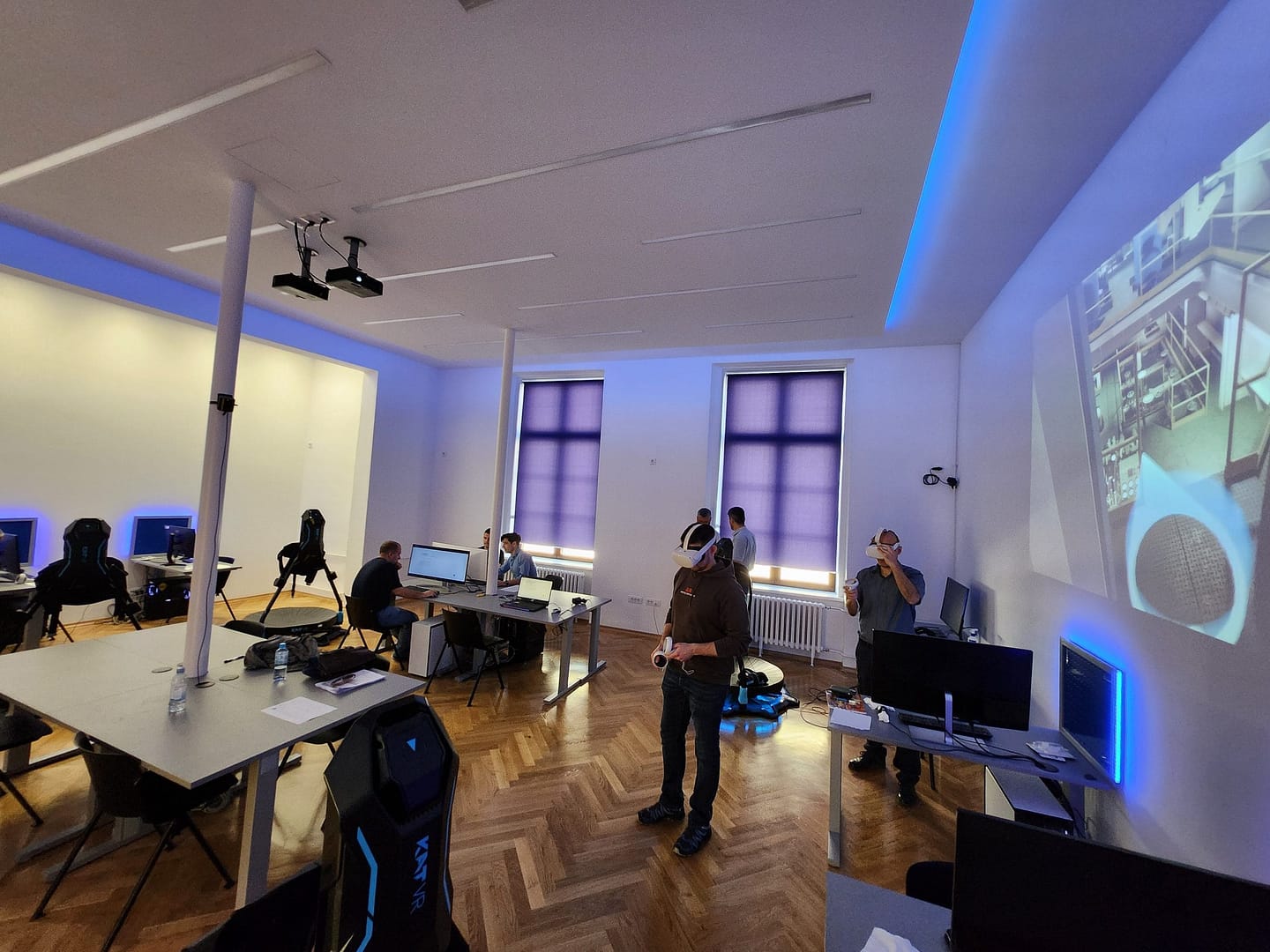Pilot project 1 – Improved fire evacuation VR model of a ship engine room
CHALLENGE! To provide improved, more realistic, albeit safer environment for onboard firefighting training.
HOW? By building fire scenario in a virtual reality (VR) environment of a ship engine room (ER), based on fire spread results obtained by computational fluid dynamics (CFD) analysis.
WHY? The problem of the current VR models is that the fire is modelled rudimentary, i.e. as a concentrated flame that does not spread, making users less susceptible on the stimulus.
FINAL RESULT→ Functional VR model of fire spread in ship ER, reaching TRL4/TRL5.
GOALS FOR INNO2MARE PROJECT: To advance maritime fire safety and to digitalize maritime education and training (MET) process making it possible to be conducted onsite and online.
Physical Setup and Prototyping
The infrastructure, facility, and equipment from the Croatian partners are located at the University of Rijeka (UNIRI), Faculty of Maritime Studies, Studentska ulica 2, 51000 Rijeka, Croatia.
The setup includes a PC workstation, VR glasses, and supporting VR software, all integrated into a mobile unit that can be transported and used at other locations as needed.
Recent Developments and Progress
Progress report on Pilot project 1 until 30.6.2025
Improved fire evacuation VR model of a ship engine room
CHALLENGE! To provide an improved, more realistic, albeit safer environment for onboard firefighting training.
HOW? By building a fire scenario in a virtual reality (VR) environment of a ship engine room (ER) based on fire spread results obtained by computational fluid dynamics (CFD) analysis.
WHY? The problem with the current VR models is that the fire is modelled rudimentarily, i.e., as a concentrated flame that does not spread, making users less susceptible to the stimulus.
FINAL RESULT→ Functional VR model of fire spread in the ship ER, reaching TRL4/TRL5.
GOALS FOR INNO2MARE PROJECT: To advance maritime fire safety and to digitalize the maritime education and training (MET) process.
PROGRESS ON ACTIONS:
| Action | Start-End | Accomplished |
| 1. State-of-the-art literature review, existing solutions analysis, mapping research gaps solutions | M1-M3 | Yes |
| 2. Selection and design of a representative ship ER | M1-M3 | Yes |
| 3. Building a VR model of ER | M4-M6 | Yes |
| 4. Developing and defining fire scenarios | M7-M9 | Yes |
| 5. CFD modelling of fire spread in ER | M10-M12 | Yes |
| 6. Implementing CFD analysis results in the VR model | M12-M18 | Yes |
| 7. Testing of the improved VR model | M19-M30 | Yes |
| 8. Equipment procurement & subcontracting | M3-M6 | Yes |
| 9. Dissemination | M1-M48 | Ongoing |
5. CFD modelling of fire spread in ER
Please see the Progress on Pilot Project 1 until 31.12.2023 (M7-M12).
6. Implementing CFD analysis results in the VR model
Please see the Progress on Pilot Project 1 until 30.06.2024 (M13-M18).
7. Testing of the improved VR model
Preliminary user testing was conducted on participants exposed to both generic and CFD-based fire. Testing was performed on 22 male firefighters, with an average age of 42.23 years and an average work experience of 19.18 years. They had no experience with fire inside the ER, but with experience in compartment fires. The second group was 33 male marine engineers with seagoing experience, with an average age of 42.55 years. Within that group, 28 had experience of fire in the ER, and 25 used a fire extinguisher on a fire in the ER.
The questions they were asked are presented in Table 1.
Table 1. A set of questions asked at the preliminary user testing.
| No. | Question | 1 (completely disagree) to 6 (completely agree) |
| 1 | The situation presented is realistic. | 1 2 3 4 5 6 |
| 2 | The depicted fire seems too artificial to me. | 1 2 3 4 5 6 |
| 3 | The way the smoke spreads in the room seems realistic. | 1 2 3 4 5 6 |
| 4 | The depicted smoke seemed too artificial to me. | 1 2 3 4 5 6 |
| 5 | I have encountered smoke similar to the one shown before. | 1 2 3 4 5 6 |
| 6 | The presented situation could help me practice dealing with such situations. | 1 2 3 4 5 6 |
| 7 | Considering my previous experience, I believe I could handle solving the situation shown. | 1 2 3 4 5 6 |
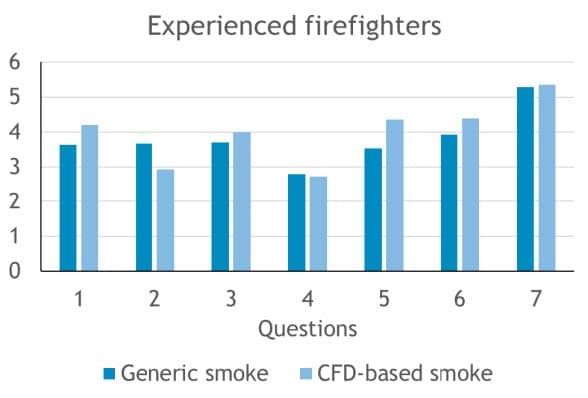
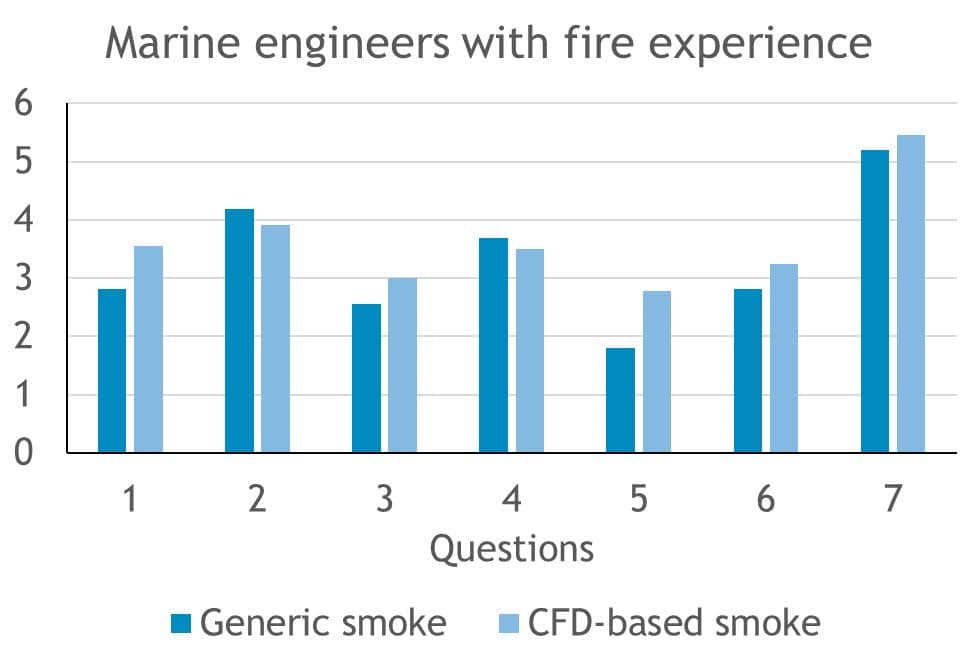
Figure 1: Arithmetic means of answers to Tab. 1 questions for: a) experienced firefighters, b) experienced marine engineers.
Performed preliminary user experience testing revealed positive feedback, indicating that:
- CFD-based smoke in VR appears more realistic than standard VR smoke,
- Situations presented in the scenario seem real,
- Presented situations could help practice dealing with such situations in real.
8. Equipment procurement & subcontracting
Please see Progress on Pilot Project 1 until 30.06.2023 (M1-M6).
9. Dissemination
The following papers have been presented at the international scientific conferences in this period:
1. Vukelić, Glujić, Bernečić, Vizentin. Using CFD and VR to Model and Visualize Fire in the Ship Engine Room, XI International Conference on Computational Methods in Marine Engineering – MARINE 2025, Edinburgh, June 2025.
Progress 30.6.2023
Progress 31.12.2023
Progress 30.6.2024
Progress 31.12.2024
Progress 30.6.2025
Lesson learnt and implementation strategy
Publications
Your Title Goes Here
Your content goes here. Edit or remove this text inline or in the module Content settings. You can also style every aspect of this content in the module Design settings and even apply custom CSS to this text in the module Advanced settings.
Application of VR Technology for Maritime Firefighting and Evacuation Training—A Review.
Vukelic, G.; Ogrizovic, D.; Bernecic, D.; Glujic, D.; Vizentin, G. Application of VR Technology for Maritime Firefighting and Evacuation Training—A Review. J. Mar. Sci. Eng. 2023, 11, 1732. https://doi.org/10.3390/jmse11091732
Abstract: Firefighting and evacuation training are important tasks in maritime education and training, especially for crews working on large passenger ships, to ensure the safety of the vessel, cargo and passengers. With the evolution of virtual reality (VR) technology and the introduction of wearable hardware, a change in paradigm has happened in firefighting and evacuation training where these new technologies are being introduced. This paper serves as a review on the use of VR technology in maritime firefighting and evacuation training, trying to answer the following questions: what is the current state of using VR technology, and what are the research gaps that need to be addressed to further accelerate the implementation of VR? Research shows that other industries have adopted the use of VR technology relatively quickly, but the maritime industry still seems reluctant. As for the research gaps, the physics-based modelling of fire spread is discussed along with two other topics: the lack of immersive solutions for evacuation and the potential for developing search and rescue scenarios onboard a ship.
Keywords: virtual reality; firefighting; evacuation; maritime education and training; passenger ship
Coupling CFD and VR for Advanced Fire Training in Ship Engine Room.
Goran Vizentin; Darko Glujic; Goran Vukelic; Dean Bernecic; Dario Ogrizovic. Coupling CFD and VR for Advanced Fire Training in Ship Engine Room. Proceedings of the International Association of Maritime Universities (IAMU) Conference. https://aga23.samk.fi/wp-content/uploads/2023/10/IAMU_Proceedings2023_Finalized.pdf
Abstract: Fire hazards on marine structures and vessels affect significantly the structural design, engineering decision making and crew training procedures. An on-board fire is extremely dynamic and case dependent phenomenon. New technologies, such as virtual reality (VR) offer a valid alternative for training in such dangerous situations. Fire and smoke exhibit fluid like behavior so computational fluid dynamics (CFD) modelling approach is necessary to ensure the realism of fire models in VR. A CFD and VR integration methodology for development of improved fire hazard marine training, comprising of ship engine room vector and bitmap model generation, CFD fire behavior analysis, results validation and
CFD/VR integration, is presented here. SMARTFIRE, an advanced CFD software package, is used to calculate fire parameters, analyze its development and spreading. Heat and smoke progression in a ship engine room environment are visualized in a VR system based on Unreal Engine. The evaluated model is
then transferred to the VR environment by linking the fire visualization parameters to the CFD analysis
data. In this first phase of the research the CFD-VR integration is done on case to case scenario basis, using the CFD time dependent results with the goal is to produce an interactive dynamical VR simulator realistic fire training environment.
Keywords: marine fire training; CFD fire modeling; VR engine room
VR fire in ship engine room - case studies
Vukelic Goran, VR fire in ship engine room – case studies, YouTube videos, 2023.
Coupling CFD and VR for advanced firefighting training in a virtual ship engine room
Darko Glujic, Goran Vukelic, Dean Bernecic, Goran Vizentin, Dario Ogrizovic , Coupling CFD and VR for advanced firefighting training in a virtual ship engine room , Results in Engineering Volume 24, December 2024, 103025.
https://doi.org/10.1016/j.rineng.2024.103025
Abstract
Firefighting training using virtual reality (VR) technology has still not been used extensively in the maritime industry. One of the reasons lies in the inability of VR to accurately replicate the true dynamics of a fire. However, this shortfall can be effectively addressed by integrating computational fluid dynamics-based (CFD) models of fire spread into VR training simulations, thereby significantly enhancing the realism and educational value of these scenarios. In this study, a scenario of a fire spread inside the ship engine room has been developed. First, as a CFD analysis, whose results were then transferred to the VR environment. That approach has been tested with users who have noted that CFD-based fire gives a more realistic appearance than the generic modelled solely using the game engine.
Keywords: Computational fluid dynamics, virtual reality, Fire, Ship, Engine room, Firefighting training, Maritime firefighting
Exploring the Perceived Ease of Use of an Immersive VR Engine Room Simulator among Maritime Students: A Segmentation Approach
David Bačnar , Demir Barić , Dario Ogrizović , Exploring the Perceived Ease of Use of an Immersive VR Engine Room Simulator among Maritime Students: A Segmentation Approach
Published in: MDPI, Appl. Sci. 2024, 14(18), 8208;
https://doi.org/10.3390/app14188208
Abstract
The integration of innovative technologies, such as Virtual Reality (VR), into maritime education presents a substantial challenge but also offers significant potential for enhancing training and knowledge transmission. This study aims to contribute to the existing body of knowledge by providing segmented insights into maritime students’ Perceived Ease of Use (PEU) of an immersive engine room VR simulator. The study analysed a sample of 58 students from the Faculty of Maritime Studies at the University of Rijeka, covering undergraduate, graduate, and specialized maritime education programs. Through hierarchical and non-hierarchical cluster analyses, two distinct segments were identified and named Proactivists and Moderates. The findings reveal significant differences between extracted sub-groups regarding (i) perceived benefits of using the VR engine room simulator in learning and education, (ii) future intention to use the technology, and (iii) overall experience. Study insights can directly aid educators and software developers in enhancing the further implementation of VR technology in maritime education.
Keywords: virtual reality; engine room simulator; segmentation; maritime education; serious game; perceived ease of use


